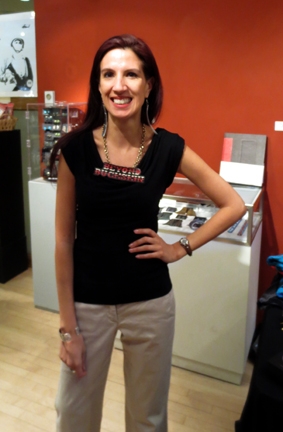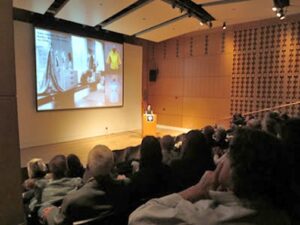By America Meredith (Cherokee Nation), March 24, 2013

Jessica Metcalfe at Beyond Buckskin’s
“Pop Up Boutique” at the IAIA Museum of Contemporary Native Arts
Now that Jessica R. Metcalfe, PhD (Turtle Mountain Ojibwe) is back on the Turtle Mountain Reservation in North Dakota, the “super important fashion Mecca,” as she jokingly says, it’s a special treat to see her down in Santa Fe. The School of Advanced Research (SAR) organized her talk at the New Mexico History Museum. Their talks have become so popular audiences can no longer squeeze into their auditorium at the SAR campus. Metcalfe earned her doctoral degree in Native American fashion from Arizona State University, and in recent years she has become a force for Native fashion.
The Institute of American Indian Arts
Metcalfe began with a quick history of Native fashion since the 1940s, beginning with Lloyd Kiva New (Cherokee Nation, 19162002) from Oklahoma, who founded a wildly successful fashion studio in Scottsdale, Arizona. He sold to Neiman Marcus and First Lady Eleanor Roosevelt wore his designs. He was the first Native American to participate in an international fashion show: the 1951 Atlantic City International Fashion Show. His studio had 15 assistants, and New collaborated with such prominent artists as Andrew Van Tsinhnahjinnie (Navajo) and Charles Loloma (Hopi). The Heard Museum just acquired hundreds of fabric swatches from Lloyd’s studio.
“Lloyd believed the oldest art form across all cultures was personal adornment,” Metcalfe says. She continues, “He felt Native cultures were essential to American identity.” New flourished as a Native designer during a time when the United States Indian Policy was actively terminating tribal recognition. The US tried to assimilate Native peoples into mainstream culture and relocate families away from their tribal homelands.
New took his philosophy about Native art and identity to Santa Fe, where he co-founded the Institute of American Indian Arts in 1962. That first decade were the “Golden Years,” with textile arts and fashion design being essential parts of the academic program.
Wendy Ponca (Osage) became the main fashion instructor at IAIA from 1983 to 1993. “As Indians,” Metcalfe quoted Ponca, “we are furthering tradition.” Ponca created body art based on Osage cosmology, almost a lost art—in the 1980s only one elder had traditional tattooing. The spider, in particular, was tattooed on the back of women’s hands. Wendy used both spider and snake imagery in fashion.
From Santa Indian Market to Project Runway

Jessica R. Metcalfe, PhD (Turtle Mountain Ojibwe) presents to a packed house at the New Museum History Museum
Ponca co-founded “Native Uprising,” the Native American fashion designer collective in the 1980s—featuring Ponca, Marcus American (Choctaw), Pilar Agoyo (Ohkay Owingeh), and many other talented IAIA students and alumni. Their innovative creations forced SWAIA to create new categories in the 1990s.
Fast forward to Patricia Michaels (Taos Pueblo), first Native American to be featured on Project Runway. After Michaels studied with Ponca at IAIA, she attended Lloyd Kiva New’s alma mater, the Chicago Art Institute. She won the 2011 SWAIA Indian Market classification for textiles. Starting with plain cloth, akin to a blank canvas, Michaels hand paints designs on her fabric. Even today detractors say her creations are “not being ‘Indian’ enough.” But Michaels keeps demolishing barriers. For example, she was the first Native American to participate in Mercedes Benz Fashion Week.
Virgil Ortiz (Cochiti Pueblo) is a fashion designer that draws inspiration from Cochiti pottery designs. These are heavily influenced by oral history, so he retells stories with his clothing design, for instance, reimagining the Pueblo Revolt of 1680. Ortiz is interested in “collapsing time.” Jessica quotes him: “We must understand ourselves as embodying past, present, and future.”
Beyond Buckskin
Jessica Metcalfe shifted the focus of her talk to her new personal project, Beyond Buckskin. She launched the blog in 2009 with just $100. Her vision statement is to “empower Native artists and design.” She started the blog to educate the public about Native fashion, sharing the history and profiling designers.
Misappropriation of customary Indigenous aesthetics has emerged as a major focus. Paul Frank, back in September, posted a thousand photos on Facebook from their “powwow party” which featured rainbow dyed chicken feather headdresses and faux tomahawks. A flood of complaints convinced the company to pull the photos from the web in 24 hours. Metcalfe followed up with an open letter to the company addressing the racism and troubling imagery from their faux Indian party. The president of Paul Frank apologized, contracted her directly, and wanted to talk. After the discussions, the Paul Frank company actually agreed to collaborate with four Native American designers, and in fact, one of their representatives was in the audience. They will unveil the new designs in August.
On May 7, 2012, Metcalfe created an online boutique space. As she encouraged people to wear clothing and accessories created by Native designers, the public constantly, “Where do we buy them?” So an online boutique was the perfect mechanism to bring designers with the public. Now Beyond Buckskin showcases 30 different designers ranging from affordable street wear to high-end couture.
Just launched on March 12 in Las Vegas, Beyond Buckskin Lookbook is a landmark publication, featuring over 15 Native designers, since, as Metcalfe says, “This needs to be a movement.”
Metcalfe concludes: “Native fashion’s biggest days are yet to come.”
Links
- Beyond Buckskin
- Jessica R. Metcalfe’s feature article, “More Than Just a Trend: Rethinking the ‘Native’ in Native Fashion,” FAAM no. 0 (April 2013).



